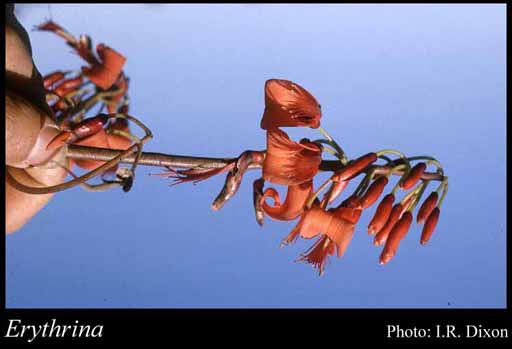- Reference
- Sp.Pl. [Linnaeus] 2:706 (1753)
- Name Status
- Current

Scientific Description
Family Papilionaceae. Phaseoleae.
Sometimes included in Leguminosae.
Habit and leaf form. Glabrate trees (with patches of stellate hairs); deciduous (usually leafless when flowering); resinous, or not resinous. Plants prickly (on the stems). Mesophytic, or xerophytic. Leaves medium-sized to large; alternate; spiral, or distichous; not imbricate; petiolate. Petioles wingless. Leaves non-sheathing; compound; pulvinate; ternate. Leaves pinnately trifoliolate. Leaves imparipinnate. Leaflets 3 (conspicuously trilobed, or bilobed by reduction of the central one); 3–11 cm long. Lateral leaflets alternate to opposite. Leaflets modified stipellate. Leaflets with swollen, glandlike stipels. Leaflets pulvinate, or epulvinate; flat; with conspicuous lateral lobes. Leaflet margins flat. Leaf blades dorsiventral; cross-venulate. Leaves with stipules. Stipules intrapetiolar; scaly, or leafy, or spiny, or represented by glands; caducous, or persistent. Leaf blade margins entire (or sinuous); flat. Leaves without a persistent basal meristem. Leaf anatomy. Hairs present; complex hairs present. Complex hairs stellate. Stem anatomy. Secondary thickening developing from a conventional cambial ring.
Reproductive type, pollination. Fertile flowers hermaphrodite. Unisexual flowers absent. Plants hermaphrodite. Pollination mechanism conspicuously specialized.
Inflorescence and flower features. Flowers aggregated in ‘inflorescences’; in panicles, in fascicles, and in racemes. Inflorescences compound; axillary; pseudoracemes with 1–3 flowers per bract. Flowers pedicellate (pendent); bracteate. Bracts deciduous (caducous). Flowers bracteolate. Bracteoles deciduous (caducous). Flowers medium-sized; very irregular; zygomorphic. The floral asymmetry involving the perianth and involving the androecium. Flowers papilionaceous (imbricate-descending, with the posterior petal outside and forming a flag (‘standard’)); basically 5 merous; tetracyclic. Floral receptacle developing a gynophore. Free hypanthium present, or absent. Perianth with distinct calyx and corolla; basically 10 (the calyx more or less modified); 2 -whorled; isomerous. Calyx present; basically 5 (but often more or less truncate, and/or split down one side and spathelike); 1 -whorled; gamosepalous; minutely 5 lobed, or entire (and sometimes unilaterally split). Calyx lobes when present, markedly shorter than the tube. Calyx imbricate, or valvate, or open in bud; exceeded by the corolla; tubular; regular, or unequal but not bilabiate; non-accrescent; with the median member anterior (when detectable). Corolla present; 5; 1 -whorled; appendiculate, or not appendiculate. Standard not appendaged (and not clawed). Corolla polypetalous (the keel petals free). The wings of the corolla free from the keel; not laterally spurred. Standard ‘normally’ developed (being the largest member, its limb somewhat reflexed); entire, or emarginate; not sericeous. Keel about equalling the wings to conspicuously exceeding the wings; not long-acuminate/beaked; neither coiled nor spiralled; not bent and beaked. Corolla imbricate (descending); glabrous abaxially; glabrous adaxially; orange to red; non-accrescent. Petals sessile (standard), or clawed (wings and keel). Androecial members definite in number. Androecium 10. Androecial members free of the perianth; markedly unequal (alternately long and short); coherent; 2 - adelphous (9 joined, one free above). The staminal tube free from the keel petals. Androecial members 1 -whorled. Androecium exclusively of fertile stamens. Stamens 10; becoming exserted; all more or less similar in shape (the anthers uniform); diplostemonous; both opposite and alternating with the corolla members; filantherous. Filaments glabrous. Anthers separate from one another to connivent; all alike; dorsifixed; versatile; dehiscing via longitudinal slits; latrorse, or introrse; tetrasporangiate. Gynoecium 1 carpelled. The pistil 1 celled. Carpels reduced in number relative to the perianth. Gynoecium monomerous; of one carpel (densely stellate-hairy); superior. Carpel stylate (the style long, incurved); apically stigmatic. Style curved. Style glabrous. Stigmatic tissue terminal. Carpel 2–100 ovuled (i.e. to ‘many’). Placentation marginal (along the ventral suture). Gynoecium median (the placenta posterior, on the ventral suture). Ovary stipitate. Stigmas capitate. Ovules pendulous to ascending; biseriate; arillate, or non-arillate; anatropous, or campylotropous to amphitropous, or hemianatropous.
Fruit and seed features. Fruit aerial; 90–150 mm long; non-fleshy (the valves tick and woody); not spinose. The fruiting carpel dehiscent; a legume. Pods much elongated (narrowly oblong); not triangular; more or less straight; not becoming inflated; regularly constricted between adjacent seeds (slightly), or not constricted between the seeds; wingless; not internally hairy. Valves of the dehisced pod not twisted. Follicles without septa. Fruit 1 celled; elastically dehiscent, or passively dehiscent. Dispersal unit the seed. Fruit 1–4 seeded. Seeds non-endospermic; not mucous; small to medium sized; non-arillate. Cotyledons 2; accumbent. Embryo curved, or bent. Testa non-operculate. Micropyle zigzag, or not zigzag. Seedling. Germination phanerocotylar to cryptocotylar.
Geography, cytology, number of species. Native of Australia. Endemic to Australia. Australian states and territories: Western Australia, South Australia, Northern Territory, Queensland, and New South Wales. X=21. A genus of about 110 species; 1 species in Western Australia; E. vespertilio Benth.; 0 endemic to Western Australia.